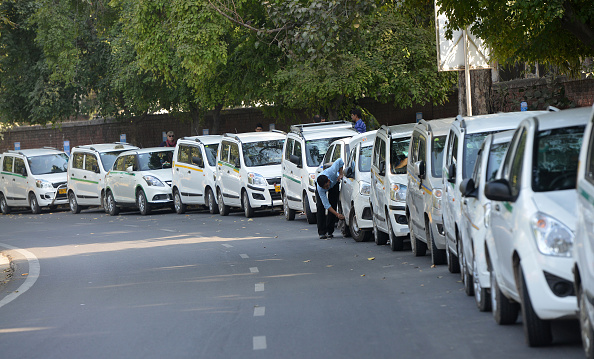
Rupindra used to be a priest in a temple in Harinagar, New Delhi. Originally from Rajasthan, his family moved to New Delhi in the late 1990s. In late 2014-15, Rupinder decided to become a full time driver at Ola and Uber. The decision was based on suggestions of his friends. His friends claimed that they earned around 70,000-80,000 rupees a month.
Rupindra says, “I was looking for a job but was not sure where to find one, based on my friends suggestion I started driving a cab under e-cab aggregators thinking I would make around around Rs 40,000 monthly after deducting other costs like fuel and maintenance.”
Initially for 3-4 years, till around 2017-18 my monthly earning used to be pretty good, but now it has gone down. This is the reason I’m no longer a driver partner with Ola and Uber and now I drive privately.”
Rupindra lists several reasons for a higher income in the past. According to him, Ola and Uber used to pay Rs 18/km. But now the rates have come down to as low as Rs 8/km. The cab aggregators also used to provide incentives for extra trips on a per day basis, but now there are no such incentives. The commission which the companies charged also used to be only 15-20% but now it has increased to 25-30%.
Rupindra says he made the decision to switch to being a private driver because since leaving cab aggregators he does not have to pay any commission to anyone or wait for incentives. “Now I take outstation fares, taking people from Delhi to hill stations like Shimla and Dharamshala. We have a fixed rate of Rs 14/15 per km. The toll charges are paid by the customers so that way whatever I earn stays with me.”
Anil, another auto-driver partner with Ola and Uber who has been driving since 2015 says that the companies show that they charge only 25% commission but they charge anywhere between 30-40% commission. He says, “If we take a trip from Indira Gandhi Airport to Mahipalpur, the bill comes to around Rs 100, but we get only Rs 30 or 40 after deducting the commission and setting aside money for CNG.”
Anil says he wishes that the company would restart some kind of incentives because that way drivers can work longer hours to earn a good incentive, but now even after taking longer trips and driving for longer hours he does earn what he used to.
Anil also points out that during rush hours when customers are charged surge prices, the drivers do not get a share of the surge price. “All of it goes to Ola and Uber, we get our share from the original rate only”, he says.
The surge pricing works on the demand-supply model. If there is more demand for cabs in a locality and less number of cabs, then the Ola and Uber algorithms calculate the surge price which is then applied for specific distances. There have been many complaints against Ola and Uber for their surge prices in the past.
In December last year the Supreme Court of India ruled in favour of Ola and Uber. The cab aggregators were challenged by advocate Samir Agarwal who had raised questions about fair practices adopted by Ola and Uber. Questions were raised as to how aggregators could fix prices without the involvement of drivers or riders.
On being asked if he would like a fixed rate set up by the government for autos, Anil was of the opinion that it would still be a better option than the current system. He says, “Right now the auto drivers earn more than us on a daily basis even if they go by metre, we have a commission to pay, we do not get any share from the surged price but for auto drivers if there is more demand and less supply the driver can earn more as the passenger has no choice.”
Anil says that he still continues to work as a driver partner because he has to feed his family and there are not many other job opportunities. So whatever 25,000-30,000 rupees he earns per month he has to live with it.
For Rahul Soni, a mass communication graduate, being a driver partner has been a blessing in disguise. He used to work for a private firm making a handsome salary, but like many other people Soni lost his job last year and then his father in 2021. He says, “I was living a good life but then due to Covid I lost my job, and then earlier this year my father died of cancer, all the savings that I had was spent on his treatment, we could not even save our house.” Now Soni lives with his mother, wife and son in a rented apartment and works as a driver partner. “I fortunately had my father’s car with me so I became a driver partner, my earnings are not what they used to be but I earn around Rupees 30,000 a month after all the deductions. Something is always better than nothing”, he signs.
(Cover: Getty Images)
The four cases are linked to the land-for-jobs and IRCTC scam, which are being probed…
This was followed by the Delhi Development Authority (DDA), which addressed 4,804 of the 5,197…
These local stores stock thicker jackets, practical sweaters, and everyday layers that are designed for…
Veer Ahlawat’s final-round 67 sealed a three-shot win at the Rs 1 crore CIDCO Open…
OnePlus has launched the 15R smartphone and Pad Go 2 tablet in India, with prices…
Nearly 2,800 Delhi vehicles denied fuel on first day of 'No PUC, No Fuel' drive…